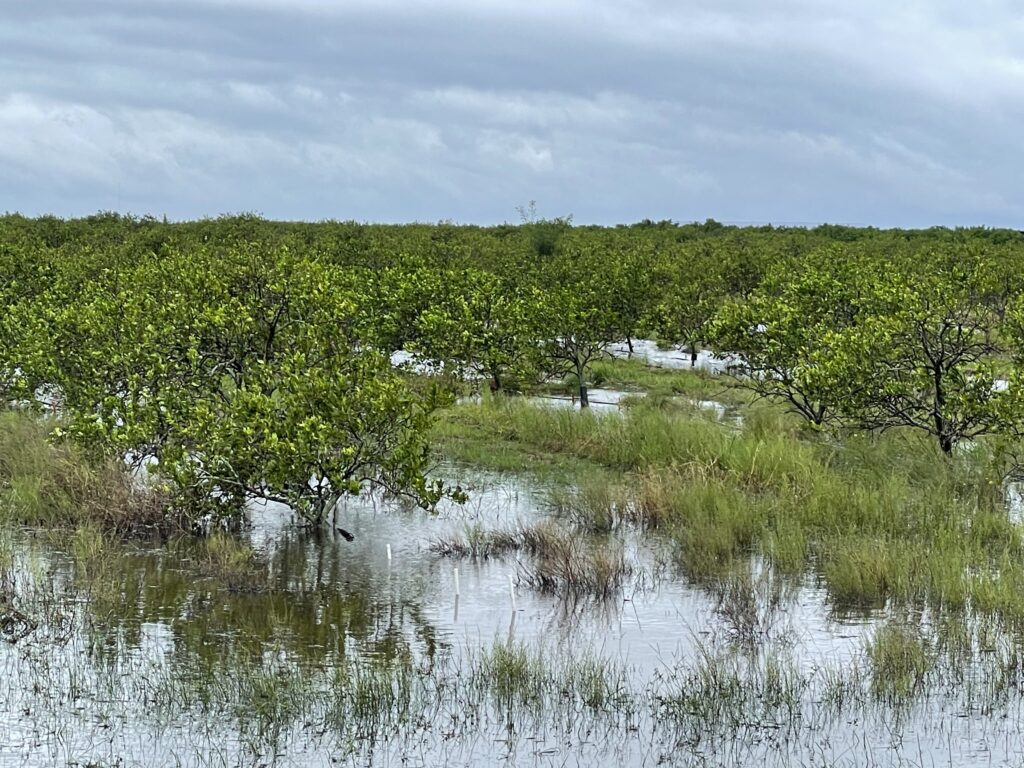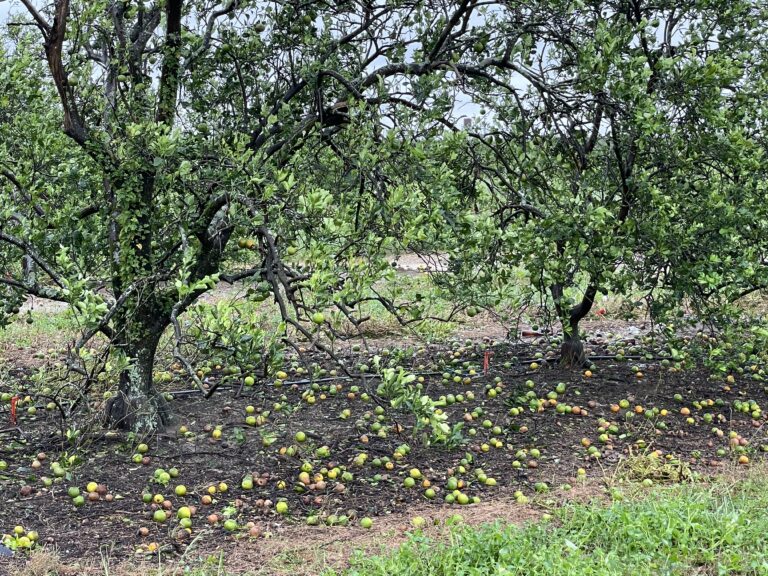Citrus industry appears to be Florida ag’s biggest Ian casualty

Within the Sunshine State’s produce industry, it is Florida’s citrus growers facing devastating damage from Hurricane Ian.
In recent days since Sept. 28, when Ian struck southwest Florida, reports from the state’s vast agricultural industry have been emerging. Of course, the hurricane not only flooded gulf-side resorts, such as Ft. Myers, but the vegetable production areas of the Everglades. Ian, the rain and wind maker, also certainly roared through Florida’s southwest and central citrus and vegetable producing areas.
Field crop planting was largely just beginning
On Oct. 4, The Ledger in Lakeland, FL, quotes Christa Court, economist and director of the Economic Impact Analysis Program for the University of Florida Institute of Food and Agricultural Sciences (UF/IFAS): “It so happens, that Hurricane Ian’s arrival coincides with the usual timeframe for plantings of most crops in the region. The crops in harvest now include avocado, oranges, grapefruit, carambola, corn, peanuts, and sweet potatoes.”
Ian hit growers in the early stages of the 2022-2023 season. The first monthly forecast of the season from the U.S. Department of Agriculture is set for Oct. 12, The Ledger notes.
Court continues: “After the storm passes, assessing the damages might not be a quick process, depending on power and telecommunication outages, limited access to farms and ranches due to flooding, and other challenges. Other effects might only appear in the long-term, including problems like soil salinity affected by storm surge along the coast.”
The Ledger credits UF/IFAS for indicating seasonal crops currently in Florida ground include over 200,000 acres of fresh market vegetables, like cucumbers, peppers, and tomatoes, over 180,000 acres of hay and 95,000 acres of field crops, like sugarcane, cotton and peanuts, officials with said. Most of the land – over three million acres – is grazing land.
IFAS estimated Sept. 28 that Ian might affect 375,000 acres of citrus groves.
Strawberry grower Nick Wishnatzki, public relations manager of Wish Farms, Plant City, tells The Ledger, “Fortunately, we held off planting as we were waiting to see Ian’s path. Around 10-15% of the plastic beds were ripped up, a few fields were completely submerged under water, and dirt was blown into the fields changing some of the grading."
“Our situation pales in comparison to other folks,” Wishnatzki says. His strawberry farm (G&D Farms) in Duette, Manatee County, sustained some damage from the wind and rain from Hurricane Ian. In Duette, "There will be additional costs to get back on track, but we don’t foresee any significant delay to the Florida season getting underway in November."
Florida citrus
On October 3, WFSU reported online, “As they begin to assess groves damaged by Hurricane Ian, Southwest Florida citrus growers are seeing conditions potentially worse than after Hurricane Irma, which played a key role in citrus production falling by more than one-third in 2017.”
Matt Joyner, executive vice president and CEO of Florida Citrus Mutual, said Sept. 30 told WFSU that it might be more than a week before Ian’s impacts are fully known. At the time, Joyner said growers in DeSoto, and Hardee counties still had fields underwater.
But Joyner says initial discussions with citrus growers make him “feel like this is going to be, for them, worse than Irma. Folks are trying to get water off their trees to the extent that they can pump water off, although in a lot of instances there's just no place to send it.”
Joyner relates that, in driving to reachable groves, he saw quite a bit of fruit on the ground, as well as standing water in groves.
“I’ve seen some trees leaning, not as many fully pushed over. But I'm hearing from growers down south that have trees completely laying over. So, this is kind of going to be the whole gamut of damages it sounds like at this point.”
Initial reports of heavy damage extended into Polk County, Joyner says. Further east, Indian River County and other citrus-growing counties have reported grapefruit on the ground, but otherwise conditions appear less dire.
“At this juncture, we're cautiously optimistic that it's not going to be as severe,” for groves in more-eastern areas. “It doesn't sound like they got quite the rainfall that they had anticipated. And, so, I'm not hearing the horrible reports of standing water and flooding over on that river area at this point,” Joyner says.
Still, WFSU reports, the initial reports aren’t good for a citrus industry that during the 2021-2022 season, for a variety of reasons, had its lowest production in eight decades.
Citrus giant Alico
A Sept. 30 press release from Alico, Inc., Ft. Myers, shared insights on its citrus damage. Alico owns 48,900 acres of citrus groves in Charlotte, Collier, DeSoto, Hardee, Hendry, Highlands, and Polk counties.
Alico’s groves sustained hurricane or tropical storm force winds for varying times.
“Field assessments are ongoing, but initial observations include significant drop of fruit from trees and the magnitude of this drop will be formally calculated by our staff and our insurance companies over the coming weeks.” As of Sept. 30, initial inspections indicated that “substantially all of our trees remain intact, with the exception of a single grove in Charlotte County that was in the direct path of the storm.”
Based upon prior experience with serious storms of this nature, Alico expects it will take at least two seasons for the groves to recover to pre-hurricane production levels. Although past experience is not a predictor of future results, “Alico saw its production increase 9% above pre-hurricane levels within a single season following Hurricane Irma in September 2017.”
Alico maintains crop insurance for catastrophic events on all of its groves. “While all of our groves experienced an impact from Hurricane Ian, not all of our groves may have suffered enough damage for insurance claims.”
Alico also notes the company “remains strong following the historic Hurricane Ian. Most importantly, we are grateful that none of our 200+ employees were casualties from this devastating storm in Southwest Florida this week.”















































